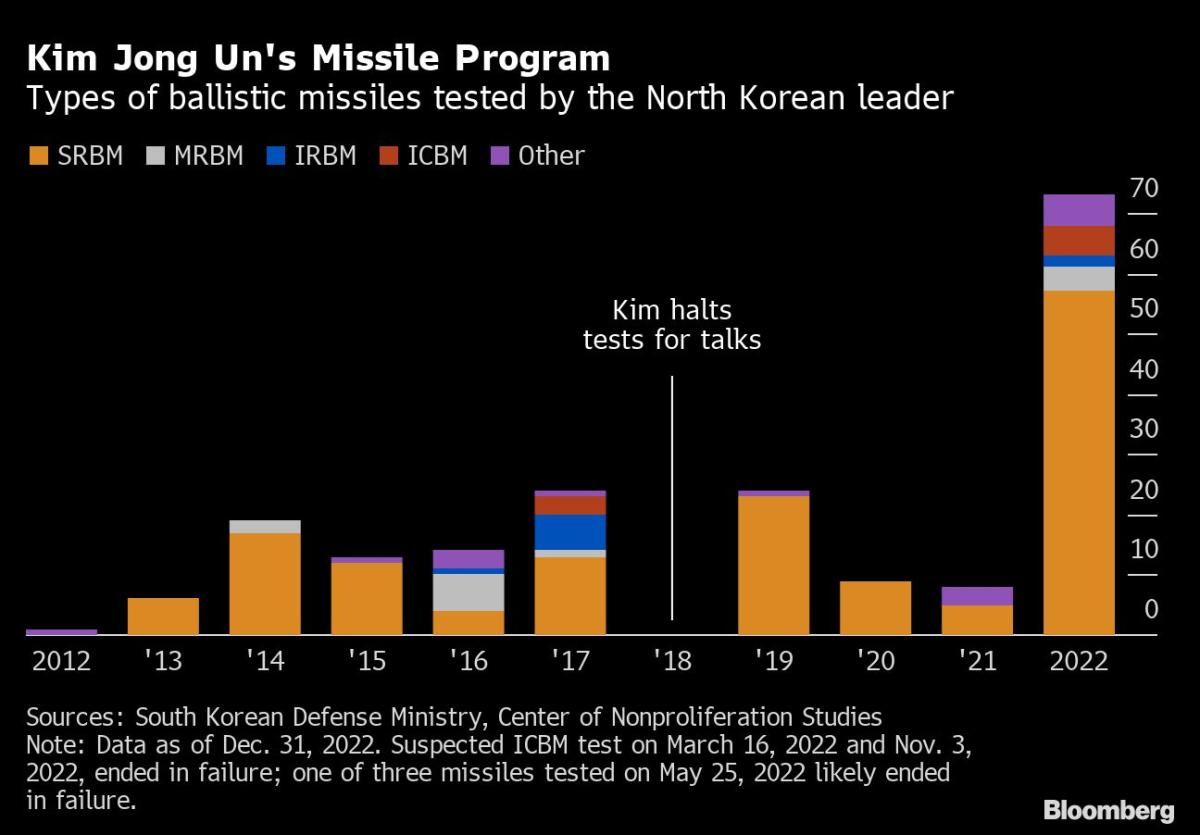
(Bloomberg) — North Korea fired at least three suspected short-range ballistic missiles Saturday, adding to its record number of launches this year as Kim Jong Un leads a major political meeting to set policy for 2023.
Most Read from Bloomberg
South Korea’s Joint Chiefs of Staff said North Korea fired the barrage from an area south of Pyongyang in North Hwanghae province toward waters off its east coast. They landed in the waters after flying about 350 kilometers (217 miles) in distance. There has been no indication that any of the missiles has fallen in waters that are a part of Japan’s exclusive economic zone.
While the missiles did not pose an immediate threat to the US or its allies, the launches highlighted “the destabilizing impact” of North Korea’s ballistic missile programs, the US Indo-Pacific Command said in a statement.
In recent months, Kim has accelerated his state’s response to actions from the US and its allies that Pyongyang sees as provocative, including sending drones to the south. The missile launch came hours after South Korea on Friday had a test-flight of a solid fuel space vehicle.
This year, Kim’s regime has already test fired about 70 ballistic missiles, the most in his decade in power and in defiance of United Nations resolutions that prohibit the launches. He has stepped up provocations in recent months in a display of anger at joint military drills in the region by the US and its allies, South Korea and Japan.
Kim has been presiding over a meeting this week of his ruling Workers’ Party to review economic and political efforts for this year and decide on policy plans for 2023. He has shown no interest in returning to nuclear disarmament talks that have been stalled for nearly three years, and has pledged to never give up his atomic arsenal.
The meeting is expected to finish this weekend and on Saturday the state’s official Korean Central News Agency said Kim has been analyzing “the recent subjective and objective situation facing our revolution and the condition and circumstances to be foreseen in the future.”
The North Korean leader has been modernizing his inventory of missiles over the past several years to make them easier to hide, quicker to deploy and more difficult to shoot down. This year, he has tested missiles designed to deliver nuclear weapons to South Korea and Japan, as well as firing off intercontinental ballistic missiles with ranges to hit the American mainland.
North Korea on Nov. 18 test-fired an ICBM with Kim’s daughter on hand for the launch, marking her first official appearance in state media. The move signaled that there’s another generation ready to take over the Cold War’s last continuous family dynasty and it will depend on nuclear weapons for its survival.
North Korea may soon raise regional tensions even higher with its first nuclear test since 2017. The US, South Korea and Japan have said for months that Pyongyang appears ready to test a device at any time and the three have pledged stern and coordinated punishments if Kim goes ahead with an atomic test.
But the North Korean leader is finding space to ramp up provocations and conduct tit-for-tat military moves against the US and its allies as President Joe Biden focuses on Russia’s war in Ukraine.
The US push to isolate Vladimir Putin, coupled with increasing animosity toward China, has allowed Kim to strengthen his nuclear deterrent without fear of facing more sanctions at the UN Security Council. There’s almost no chance Russia or China, which have veto power at the council, would support any measures against North Korea, as they did in 2017 following a series of weapons tests that prompted former President Donald Trump to warn of “fire and fury.”
–With assistance from Max Zimmerman and Sangmi Cha.
(Updates with distance flown by the missiles, US Indo-Pacific Command’s statement)
Most Read from Bloomberg Businessweek
©2022 Bloomberg L.P.




